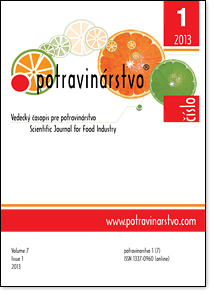Comparison of the sensitivity of determining soyeabean allergens by ELISA method and SYBR green I
DOI:
https://doi.org/10.5219/311Keywords:
ELISA, PCR, soybean, allergen, SYBR Green IAbstract
The aim of this study was to compare the suitability of two methods for detecting defatted soybean powder; SYBR Green I Real-time PCR and enzyme-linked immunosorbent assay (ELISA). Analysis of 20 artificially contaminated samples prepared by simple dilution with wheat flour revealed that both techniques were able to detect defatted soybean powder, although there were significant differences between the two methods. Wheat flour contamination with defatted soybean powder was detected in samples 1-5, (0.012 %; 120 mg.kg-1), but not in samples with lower contamination with soybean powder saples 6-20 using SYBR Green I real-time PCR. Samples 1-10 could not be quantified by ELISA as the absorbance values were greater than the detection limit, and while samples 11-20 were measured, only the values of samples 16, 17 and 18 were within the guaranteed quantification range specified by the ELISA kit manufacturer. Defatted soybean powder contamination was detected in samples 19 and 20, but absorbance values were highly similar to those of the negative control sample.
Downloads
Metrics
References
Brown, S. G. A., Mullins, R. J., Gold, M. S. 2006. Anaphylaxis: diagnosis and management. The Medical Journal of Australia, vol. 185, p. 283-289. PMid:16948628 DOI: https://doi.org/10.5694/j.1326-5377.2006.tb00563.x
Dreskin, S. C. 2006. Genetics of food allergy. Current Allergy and Asthma Reports, vol. 6, no. 1, p. 58-64. https://doi.org/10.1007/s11882-006-0012-9 PMid:16476197 DOI: https://doi.org/10.1007/s11882-006-0012-9
Espineira, M., Herrero, B., Vieites, J. M., Santaclara, F. J. 2010. Validation of end-point and real-time PCR methods for the rapid detection of soy allergen in processed products. Food Additives and Contaminants, vol. 27, no. 4, p. 426-432 https://doi.org/10.1080/19440040903493777 PMid: 20178017 DOI: https://doi.org/10.1080/19440040903493777
Flinterman, A. E., Knulst, A. C., Meijer, Y., Bruijnzeel-Koomen, C. A. F. M., Pasmans, S. G. M. A. 2006. Acute allergic reactions in children with AEDS after prolonged cow's milk elimination diets. Allergy, vol. 61, no. 3, p. 370-374. https://doi.org/10.1111/j.1398-9995.2006.01018.x PMid:16436148 DOI: https://doi.org/10.1111/j.1398-9995.2006.01018.x
Hernández, M., Rodríguez-Lázaro, D., Esteve, T., Prat, S., Pla, M. 2003. Development of melting temperature-based SYBR Green I polymerase chain reaction methods for multiplex genetically modified organism detection. Analytical Biochemistry, vol. 323, no. 2, p. 164-170. https://doi.org/10.1016/j.ab.2003.07.015 PMid:14656521 DOI: https://doi.org/10.1016/j.ab.2003.07.015
Heine, R. G., Elsayed, S., Hosking, C. S., Hill, D. J. 2002. Cow's milk allergy in infancy. Current Opinion in Allergy and Clinical Immunology, vol. 2, no. 3, p. 217-225. https://doi.org/10.1097/00130832-200206000-00011 PMid: 12045418 DOI: https://doi.org/10.1097/00130832-200206000-00011
L'Hocine, L., Boye, J.I., Munyana, C. 2007. Detection and quantification of soy allergens in food: study of two commercial enzyme-linked immunosorbent assays. Journal of Food Science, vol. 72, no. 3, p. C145-153. https://doi.org/10.1111/j.1750-3841.2007.00298.x PMid: 17995793 DOI: https://doi.org/10.1111/j.1750-3841.2007.00298.x
Karudapuram, S., Batey, D. 2008. Detection of Genetically Modified Soybean Detection of Genetically Modified Soybean in Processed Foods Using Real-Time Quantitative PCR with SYBR Green I Dye on the DNA Engine Opticon® 2 System. In Aplication note, vol. 1, 2008, no. 1, Bio - Rad, MJ Research, Inc.
Koppelman, S. J., Lakemond, C. M., Vlooswijk, R., Hefle, S. L. 2004. Detection of soy proteins in processed foods: literature overview and new experimental work. Journal of AOAC International, vol. 87, no. 6, p. 1398-1407 PMid:15675452 DOI: https://doi.org/10.1093/jaoac/87.6.1398
Novembre, E., Vierucci, A. 2001. Milk allergy/intolerance and atopic dermatitis in infancy and childhood. Allergy, vol. 56, no. S67, p. 105-108 https://doi.org/10.1111/j.1398-9995.2001.00931.x PMid:11298023 DOI: https://doi.org/10.1111/j.1398-9995.2001.00931.x
Pedersen, M. H., Holzhauser, T., Bisson, C., Conti, A., Jensen, L. B., Skov, P. S., Poulsen, L. K. 2008. Soybean allergen detection methods - A comparison study. Molecular Nutrition and Food Research, vol. 52, no. 12, p. 1486-1496 https://doi.org/10.1002/mnfr.200700394 DOI: https://doi.org/10.1002/mnfr.200700394
Tengel, C., Schüßler, P., Setzke, E., Balles, J., Sprenger-Haußels, M. 2001. PCR-based detection of genetically modified soybean and maize in raw and highly processed foodstuffs. BioTechniques, vol. 31, no. 2, p. 426-429. PMid:11515380 DOI: https://doi.org/10.2144/01312pf01
Wang W. Y., Fang T. J. 2005. Development of multiplex and quantitative PCR assay to detect genetically modified roundup ready soybean in foods. Journal of Food and Drug Analysis, 13, p. 132-138 DOI: https://doi.org/10.38212/2224-6614.2537
Zhang, M., Gao, X., Yu, Y., Ao, J., Qin, J., Yao, Y. Li, Q. 2007. Detection of Roundup Ready soy in highly processed products by triplex nested PCR. Food Control, vol. 18, no. 10, p. 1277-1281. https://doi.org/10.1016/j.foodcont.2006.09.001 DOI: https://doi.org/10.1016/j.foodcont.2006.09.001
Žiarovská, J., Fernández, E., Millela, L. 2013. A revised ITS nucleotide sequence gives a specifity for smallanthus sonchifolius (Poepp. and Endl.) and its products identification. Genetika. vol. 45, no. 1, p. 217-226. https://doi.org/ 10.2298/GENSR1301217Z DOI: https://doi.org/10.2298/GENSR1301217Z
Žiarovská, J., Poláčeková P. 2012 Efficiency of real-time PCR for 18S RRNA amplification of Sorbus domestica, L.. Potravinarstvo. vol. 6, no. 3, p. 47-49. https://doi.org/10.5219/203 DOI: https://doi.org/10.5219/203
Downloads
Published
How to Cite
Issue
Section
License
This license permits non-commercial re-use, distribution, and reproduction in any medium, provided the original work is properly cited, and is not altered, transformed, or built upon in any way.






























